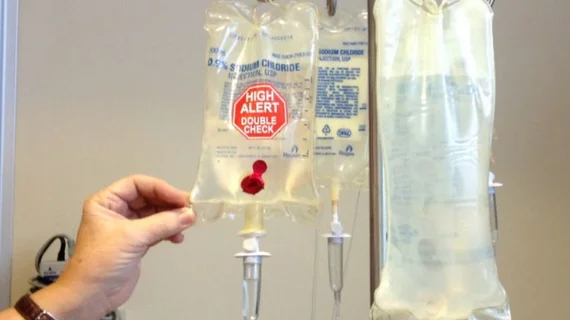Some chemo drugs might be more heart-safe than others
Current conversion ratios may be underestimating the long-term cardiotoxicity of common chemotherapy agents like mitoxantrone and overestimating the cardiovascular risk of anthracyclines like daunorubicin, researchers reported in JAMA Oncology Jan. 31.
The five-year survival rate of childhood cancer patients is approaching 85 percent, senior author Eric J. Chow, MD, MPH, and co-authors wrote, which means more survivors are living into their senior years. But the cumulative incidence of cardiomyopathy in those patients by the time they reach their 40s and 50s is rising, too, and exceeds 25 percent in some studies.
“The design of cancer treatment protocols is informed by both the anti-tumor efficacy and toxicity profile of an agent,” Chow, of the Fred Hutchinson Cancer Research Center in Seattle, and colleagues wrote in the journal. “For many treatments, the traditional assumption has been that the antileukemia potency of an agent is proportional to its acute hematologic toxicity, and, by extension, proportional to toxicity in other organ systems. However, data in both pediatric and medical oncology supporting this assumption in relation to cardiotoxicity are limited.”
Around half of kids with cancer are treated with either anthracyclines like doxorubicin, daunorubicin, epirubicin and idarubicin or an anthraquinone like mitoxantrone, the authors said. The Children’s Oncology Group substitution rules consider daunorubicin and epirubicin isoequivalent to doxorubicin, while mitoxantrone and idarubicin are considered four to five times more toxic than doxorubicin.
To test those commonly accepted equivalence ratios for late-onset cardiomyopathy, Chow et al. analyzed a group of 28,423 childhood cancer patients who survived for at least five years after their initial diagnosis. Pooled information included data that ranged from 1962 to 2005, and the researchers obtained cumulative doses of each therapeutic agent, as well chest radiotherapy exposure data, from medical records.
A third of patients (9,330 people) were treated with doxorubicin, the most common drug in the study. An additional 16 percent (4,433) were treated with daunorubicin, 1 percent (342) received epirubicin, 0.8 percent (241) received idarubicin and 0.9 percent (265) were treated with mitoxantrone. After a mean follow-up of 20 years, Chow and his team identified 399 total cases of cardiomyopathy.
Relative to doxorubicin, the equivalence ratios for other chemo agents were 0.6 for daunorubicin, 0.8 for epirubicin and 10.5 for mitoxantrone, meaning that by the time cancer survivors were 40 years old, mitoxantrone was 10 times—or more—as cardiotoxic as the same dose of doxorubicin, while daunorubicin was approximately half as cardiotoxic. Epirubicin seemed to be isoequivalent to doxorubicin, and idarubicin outcomes were too rare to report.
The authors said their estimates for mitoxantrone suggest the presently accepted conversion ratio of 4 may “substantially underestimate” its long-term cardiotoxicity risk in children, while a daunorubicin ratio of 1 might overestimate cardiotoxicity.
“Even as there is growing interest and development of more targeted therapies that rely on activating the immune system, for the foreseeable future, conventional cytotoxic agents, such as anthracyclines and mitoxantrone, will remain an integral part of treatment of many childhood cancers,” they wrote. “To reduce morbidity in future generations of long-term survivors, we will need to continue to test the efficacy of combination chemotherapy that incorporates less cardiotoxic agents as well as investigate new formulations and other cardioprotective strategies.”
Related Cancer Therapy Cardiotoxicity Content:
Succeeding with Cancer: Using Imaging to Avoid Treatment-induced Heart Failure
Providers must rethink traditional imaging approaches to prevent cardiotoxicity in cancer patients
CV programs struggling to keep up with growing demand for cardio-oncologists
Machine learning predicts drug cardiotoxicity
Prior cardiotoxicity linked to 30% increased risk of CHF during pregnancy
CV outcomes underreported in pivotal anticancer trials
CDK2 inhibitors protect cancer patients from anthracycline-induced cardiotoxicity
Genetic variants could be key to identifying chemo-induced cardiotoxicity
T2 mapping may uncover cardiotoxic marker early enough to prevent heart failure
Cardiac MRI-derived T2 mapping may help heart failure patients
Genetic variant linked to chemotherapy-induced cardiomyopathy
Study calls for better collaboration between cardiologists, oncologists
Cardiac monitoring may protect high-risk breast cancer patients against heart failure

